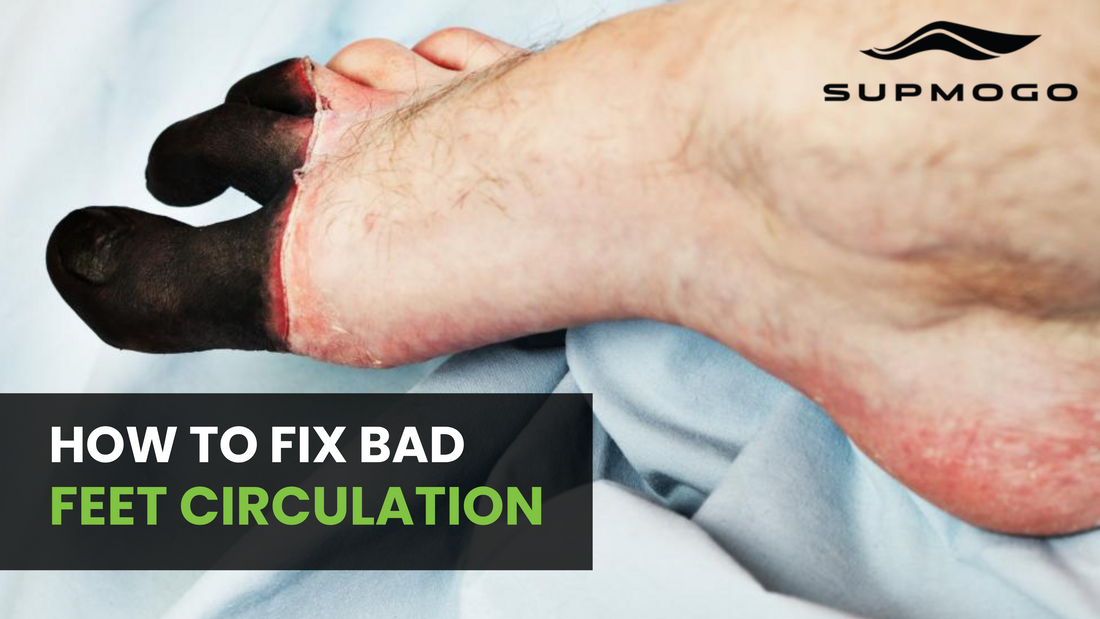Are you facing numbness, coldness, or discoloration in your feet and have no idea why these mishaps are happening? Then you might be suffering from bad feet circulation.
Now there will be infinite questions running around your mind that may include what causes bad feet and what bad circulation in feet looks like.
Worry not; we've highlighted all the essential information about bad foot circulation and how you can recover from it.
Venous insufficiency is one of the common causes of bad blood circulation and directly impacts the feet. According to research, the chronic venous disease could be due to genetic predisposition, but limited information is available about its etiology, so further investigation is needed. [1]
Does bad circulation cause cold feet? Definitely! If you're facing bad circulation in your feet or hands, you can also feel the coldness of body parts in the summer or hot season. Now let’s have an in-depth look on:
- What is Bad Feet Circulation?
- Symptoms
- Risk Factors
- Treatment of Bad Feet Circulation
- Massage
- Compression Socks
- Stay Warm
- Avoid Nicotine, Alcohol, and Caffeine
- Breathing and Relaxation Exercises
- Take Care of Your Diet
- Tai Chi and Yoga
- Stretch
- 7 Best Ways to Improve Blood Circulation in Your Body
- How to Reverse Poor Circulation in Good One
- SUPMOGO RecoveryFlex System
- When to Contact a Doctor?
What is Bad Feet Circulation?
Your body works like a transport to circulate blood, oxygen, and nutrition around your body's cells through the circulatory system. Sometimes blood vessels in the cell become hard or close by narrowing; because of this hardness, you may face reduced blood circulation.
The hardness causes bad circulation in feet and hands, due to which you may feel numbness in your hands and feet while doing work, sitting, or sleeping in one position for a long time.
Furthermore, some diseases like Raynaud's disease, diabetes, arteriosclerosis, and peripheral artery disease can also cause poor circulation to the legs and hands, making them white, blue, and ugly.[2]
To manage this condition effectively, you first have to look for the symptoms to confirm your disease and then take proper treatment accordingly.
Let's discuss the symptoms and causes of bad foot circulation in detail below for your better understanding!
Symptoms
The basic and common symptoms of bad circulation in feet are;
- Weakness of toenail
- Your wounds take several days to heal
- Discoloration of your fingers, toes, and nails
- Numbness
- Tingling feeling
- Burning sensations
- Feeling of cold extremities
- Cramps
- Too much dry or cracked heels
These are all the primary bad foot circulation symptoms you should remember.
Risk Factors:
The following factors enhance the risk of developing bad feet circulation:
- Smoking
- Lack of physical activity
- High blood pressure
- Diseases like diabetes, peripheral artery disease, varicose veins, and obesity
Treatment of Bad Feet
If you're facing any of the above bad circulations to feet symptoms, firstly relax, then start doing some essential exercises and take multivitamins to manage this condition better.
Besides the following things can help:
▪️ Massage
Massage is the best treatment for bad feet since it improves circulation, eases pain, and reduces tension.
▪️ Compression Socks
They apply pressure to the lower legs, prevent blood clotting and lessen pain and swelling.
▪️ Stay Warm
Remember to keep yourself hydrated and warmer; warmness can control the pain and numbness in your feet.
▪️ Avoid Nicotine, Alcohol, and Caffeine
Caffeine, alcohol, and nicotine contract the blood vessels and may stop or slows blood circulation in the body. It is proven by research that caffeine decreases blood flow by constricting blood vessels.
▪️ Breathing and Relaxation Exercises
Relaxation and breathing exercises work wonders in controlling and improving blood flow into the human body.
▪️ Take Care of Your Diet
Avoid eating sugar-filled desserts, trans-filled fats, and a low-fiber diet. Start consuming a heart-healthy diet, and some supplements like folic acid, antioxidants, beta-carotene, and vitamin E can also help.
▪️ Tai Chi and Yoga
Yoga and tai chi are also very useful in relaxing the muscles and relieving the pains of the hands and feet due to bad blood circulation.
▪️ Stretch
Try stretching exercises as much as possible; stretchiness releases the muscles and improves blood circulation.
Following the tips mentioned above can help to improve bad circulation in feet symptoms.
7 Best Ways to Improve Blood Circulation in Your Body
Improving your blood circulation is very necessary for every human being alive. Every part of your body needs proper oxygen and nutrients, which is restricted by poor blood circulation.
If you want to deliver all the essential nutrients, oxygen, and blood to your body parts, follow these seven mind-blowing ways and improve your blood circulation to live like a newborn stressed-free baby.
- Drink at least eight glasses of water daily to prevent your blood from thickening.
- Avoid sitting too much since it can strain your muscles and hinder proper blood flow. So, whether you are a struggling entrepreneur or have a full-time job, remember to leave your work desk and take proper breaks. Stand up, stretch your muscles and move around.
- Twist since it relieves strain and stress and works like a magician in improving your blood flow. Try twisting your body parts, and doing so regularly can help to improve your posture.
- If your feet are swelling, lie on the floor and raise your feet at the wall. This position will help in soothing your numbness, tingling, and pain caused by poor blood circulation.
- Add plant-based food to your diet, and spend some time at an open place. Go on a walk at a place filled with trees, inhale the fresh air, and your blood circulation will improve significantly.
- Excessive meat consumption can increase your cholesterol levels, and high cholesterol means poor blood circulation. So, keep your meat consumption under check.
- Brushing off your body seems weird, but yes, when you brush your body, your blood flow increases. Try this method after every shower, and you'll be amazed by the results.
Also Read: What Causes Arthritis? Symptoms and Treatments
How to Reverse Poor Circulation in Good One
Would it be possible to reverse the whole process? Moreover, what is good for poor circulation in the foot? Yes! You can reverse this process, and it’s possible to turn bad circulations into good ones.
Just like our bathrooms get sometimes blocked, our arteries also get blocked due to the thickness of the blood vessels flowing through cells inside the body.
To keep your arteries healthy and functional, first, you must improve your lifestyle. If you smoke, you should quit it as soon as possible since smoking leads to hardening blood vessels.[3]
To reverse the whole place, improve your diet, and eat healthy food instead of consuming empty carbs. Elevate your legs daily for up to twenty minutes above your heart to reduce swelling, pain, and numbness. Elevation also helps in increasing blood flow and overcoming bad foot circulations.
Besides, when you start treatment, remember to follow it for up to 3 months even if your condition improves. Leaving the treatment in between can cause the return of your pains. It's better to stay extra alert and consistent until you actually get better.
SUPMOGO RecoveryFlex System
Improving blood circulation in your body is essential for a healthy lifestyle. If you’re one of those people who need strengthening and rehab for your feet, muscles, and body, SUPMOGO RecoveryFlex System is your answer.
It is created by doctors to provide immediate relief for aches and, at the same time, strengthen your muscles and core. A strong core means better blood circulation throughout the body.
Additionally, the belt uses proprietary conductive fabric perfectly integrated into it. Which means you'll get 10X better results in no time. It has anti-odor and anti-bacterial properties, making the belt a perfect option for every user.
Bid farewell to numbness and discoloration of feet by using SUPMOGO Fitness Tools .
When to Contact a Doctor?
Any disease, pain, or symptoms that last up to two weeks should be immediately checked by the doctor to diagnose any undergoing problem you are unaware of. If you face any of the symptoms below, go to your doctor asap.
- Swelling in limbs
- Pain begins from the calf and affects your limb.
- Unusual discoloration of skin and warmness.
The symptoms indicate a life-threatening disease of deep vein thrombosis. Better to get into action before it's too late.[4]
Final Words
Bad foot circulation can affect your routine life if it isn't treated on time. The discoloration and numbness of your feet can appear on their own or occur due to any underlying disease.
Making lifestyle changes like eating healthy, taking supplements, and stretching can help improve its symptoms. However, if your symptoms are not relieved even after trying these treatment options, it's better to consult a podiatrist.
[1] Fowkes, F. G. R., Evans, C. J., & Lee, A. J. (2001). Prevalence and risk factors of chronic venous insufficiency. Angiology, 52(1_suppl), S5-S15.
[2] Valdovinos, S. T., & Landry, G. J. (2014). Raynaud syndrome. Techniques in vascular and interventional radiology, 17(4), 241-246.
[3] Benowitz, N. L., & Burbank, A. D. (2016). Cardiovascular toxicity of nicotine: implications for electronic cigarette use. Trends in cardiovascular medicine, 26(6), 515-523.
[4] Lensing, A. W., Prandoni, P., Prins, M. H., & Büller, H. R. (1999). Deep-vein thrombosis. The Lancet, 353(9151), 479-485.

